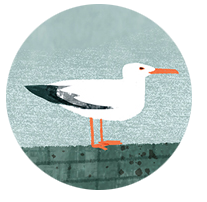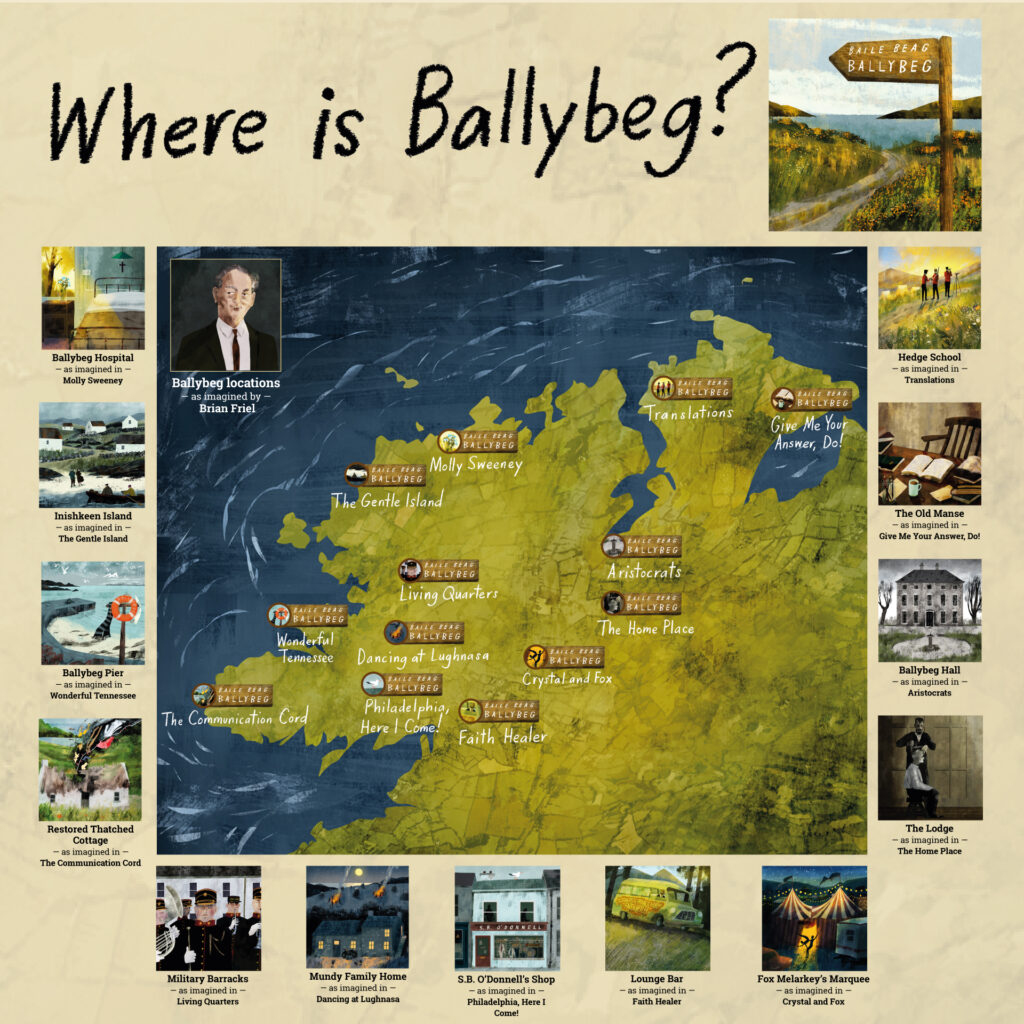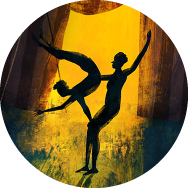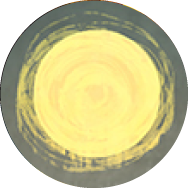

BRIAN FRIEL: Ballybeg is a village of the mind, more a depository for remembered or invented experience than a geographical location.¹

Welcome to this digital exhibition about the literary world of Brian Friel’s Ballybeg. One thing we know for sure is that the fictional town of Ballybeg is situated in County Donegal in the Northwest of Ireland. This exhibition makes connections between Ballybeg, as imagined in the plays of Brian Friel, with the real world of Donegal. The project aims to suggest interconnections between these two worlds as evidenced through the text of the plays and through Friel’s own words in his notebooks, diaries, interviews, articles, and programme notes.
Please take time to view the short introduction video from the curator and researcher of the project, Dr Harriet Purkis…
On the front page, you see a grid of illustrations in sixteen squares. Each square is either about one play written by Brian Friel that is set in Ballybeg, or about one of the following themes: Brian Friel, Ballybeg and Donegal.
✭ Click on a square and explore!
✭ Feel free to click on the images to enlarge them!
✭ Go back to the HOME PAGE at any time by clicking on the grid icon BACK TO THE PLAYS.
Each play has content organized into sections:
✭ Ballybeg Imagined – the time and place in which the particular Ballybeg in each is located.
✭ Ballybeg on Stage – theatrical performances of the play.
✭ Ballybeg Atmosphere – revealing the mood of Ballybeg in each play.
✭ Real Places – real towns and natural features in Donegal that appear in the play.
✭ Inspiration – memories, historical or literary reading, political events, or people, as well as Friel’s short stories that may have influenced the play.
✭ Writing Process and Archive – manuscripts, diary extracts, letters, and additional images.
✭ Sources – full details of where the quotations, images and documents come from.
In the other three sections, you will find three maps.
✭ Brian Friel’s World – A map showing key places in Donegal relating to Brian’s life, surrounded by personal images. An illustrated life story follows.
✭ Where is Ballybeg? – A map showing suggested locations of Ballybeg based on the text of each play, surrounded by new illustrations. The A-Z of Ballybeg is a compiled list of the buildings and natural places in all the Ballybegs put together.
✭ Donegal Settings – A map pinpointing real places mentioned in the plays, surrounded by postcards of the type of houses and landscapes as imagined in Brian Friel’s plays.
This exhibition is for anyone who wants to find out more about the world of Ballybeg and County Donegal as seen through the eyes of the playwright Brian Friel. It aims to excite, inspire, and develop curiosity about the literary landscape within which Friel created his plays. It does this by being an interactive exhibition, as well as visually exciting and providing plenty of things to read. It allows you to take your own journey through Ballybeg, by exploring whichever sections you want, at your own pace. This exhibition may inspire you to navigate your future journey with Friel by pointing out directions for further reading and stimulating your interest. It is a public project that aims to be accessible and enjoyable to all.
You are invited to visit Ballybeg. There are many different Ballybegs, in different parts of Donegal and in different homes and in different time periods. It was a surprise to locate Ballybeg in such a variety of possible places in Donegal. The most well-known plays such as Dancing at Lughnasa may ‘set’ Ballybeg in our minds as being Glenties in the 1930’s. But this is just ONE Ballybeg. There are other plays set in a different manifestation of Ballybeg, imagined in and inspired by a different part of Donegal. Whereas one Ballybeg is located, ‘Only twenty miles away’ from the Border with Northern Ireland (Aristocrats), another is ‘A pub, a lounge bar really, outside a village called Ballybeg, not far from Donegal Town’ (Faith Healer). The diversity of settings within Ballybeg include for example: The Fox Melarkey Show marquee (Crystal and Fox); Ballybeg Pier (Wonderful Tennessee); Ballybeg Hospital (Molly Sweeney) and a detached house close to a small military barracks (Living Quarters).
The plays are set in different historical times. There is quite a considerable time span amongst the plays. Indeed, the earliest play set in Ballybeg is Translations in ‘Late August 1833’, and the latest play, Give Me Your Answer, Do! in ‘The present 1997’. And every time in between: Home Place is set in ‘Summer, 1878’; Dancing at Lughnasa in ‘August 1936’; Philadelphia, Here I Come! in ‘The present, 1964’, and Molly Sweeney in ‘The present, 1994’.
The plays are speckled with humour and expressions from Donegal daily discourse, showing Ballybeg is soaked in County Donegal, not just located in it. The colloquialisms in Friel’s writing show the Donegal within Ballybeg. For example, Christine in Dancing at Lughnasa comments on her hair as being like a gorse bush, ‘Mine’s like a whin-bush. Will you wash it for me tonight, Maggie?.’ Gar in Philadelphia, Here I Come! expresses, ‘I’ve stuck around this hole far too long.’ Other expressions in the dialogue are local such as, ‘Get the knickers off, all you Glasgow women! The Inishkeen stallions is coming!’ (Bosco in The Gentle Island); and Crystal says, ‘Amn’t I rotten, my Fox?’ (Crystal and Fox).

The words you will read in this exhibition are Brian Friel’s own words. The words are quotes from the text of his Ballybeg plays. Other words are from his letters, diaries, interviews, and autobiographical writings, and his short stories. The exhibition does not draw on secondary interpretations of his words in books and articles about Brian Friel. There is not an emphasis on discussing the literary nuances or historical significance of these words. Of course, his words have been picked out, selected, arranged, and structured into this presentation, which is itself a form of interpretation or curation of primary sources.
The images in this exhibition are from various sources: illustrations, photographs, and postcards. They help imagine and visualize Ballybeg, and Donegal. Firstly, there are sixteen specially commissioned new illustrations by Dermot Flynn, beautifully capturing aspects, locations, and atmospheres of the plays. And there is a new portrait of Brian Friel himself, and a background map of Donegal. Secondly, Mitchell Davies used the blank canvas of the Donegal map, to design three brand new creative maps: Brian Friel’s World, Where is Ballybeg? and Donegal Settings. Thirdly, there are photographs of real places such as the primary school Brian attended and the houses he lived in. Fourthly, there are postcards of Donegal from the Twentieth Century, kindly sourced from the Donegal County Museum collection. Old postcards were chosen to convey a sense that Friel was writing plays set in what is now the past. But it must be remembered that although some plays were written about people and places from over one hundred years or more ago, Friel’s plays were very often set ‘in the present’ (1960’s – 1990s) and were modern plays, contemporary to the time he was writing. Postcards of a street or a mountain, convey a stylized image of Donegal, a representation that has a visual quality that is both real (fact) and unreal (fiction) all at once, creating an overlapping sense that Ballybeg and Donegal are one place.
The archives and manuscripts in this exhibition are Courtesy of the National Library of Ireland, and with very kind permission of the Brian Friel Estate. They include letters, diaries, and theatre programmes. It is just a selection, and there are many more gems in The Brian Friel Papers. The exhibition has copies of actual pages of Brian Friel’s manuscripts of his plays – some handwritten and some typed. Queen’s University pioneered this work by producing digital copies of the drafts of a selection of plays. Other items such as the birth certificate and census records come from our own research into public records. You can also see photographs of previous performances from plays produced in theatres. Many theatres kindly responded to our appeal for programmes, images, and videos of their Friel productions. These include a significant contribution from Donegal’s own An Grianán Theatre that Brian was closely associated with, for which the project is particularly grateful for and delighted to showcase.

BRIAN FRIEL: The task of writing the play, the actual job of putting the pattern together, itself generates belief in the pattern… map-makings.²
This project has attempted to unpick the pattern of the plays, and find clues to geographical locations, inspirations, atmospheres, and stories in Friel’s creative process. Where are Friel’s plays located? Physically, in the place called Ballybeg in County Donegal in Ireland, and mentally within the playwright’s thoughts, memories, and craft. Mapping a place may imply a geographical measuring and plotting. A map of roads and towns. But in this project, it refers more to mapping a sense of place and a writer’s creative process, and tracing Brian Friel’s inspirations and fictional plays with overlaps between the imagined and real worlds, places, and people.
Mapping can be simply about making a map – a visual representation of the physical parts of a place, with its towns and natural features. In this case, mapping also means to map associations between the place of Donegal and Brian Friel’s own thoughts, memories, family, ideas, and stories, which have inspired the literary world of Ballybeg in his plays. The sources drawn on are the play texts and what Brian Friel himself has said about the plays. It considers links between the writer’s experience and understanding of the real world of Donegal and the fictional world of Ballybeg that he invented. Can we find traces of the real Donegal in the imagined world of Ballybeg? And what are these specifically? For example, references to real life stories, memories, family members, settings, colloquial language, or atmospheres of the times. Like a jigsaw, Ballybeg has been reimagined in this virtual exhibition by picking up pieces and putting them down in a certain order.
This is a creative project, exploring a creative writing process about the Ballybeg plays written by Friel. Mapping the imagined places, people, dialogue and stories, to the personal associations he had with places, people and personal memories and stories in Donegal, is an attempt to link what is real (the places in Donegal he experienced in his life and people and memories from it) to what is not (the fictional village of Ballybeg, characters and plots). No one can ever be sure about any of these associations, but by going back to the play text and the primary sources of manuscripts and diaries, there are connections that can be suggested from the playwright’s own words.
The creative process of making this exhibition with Mitch Davies and Dermot Flynn was truly collaborative. The core concept of the grid of square illustrations, came from the grids seen on Ordnance Survey maps. This is with a nod to the play Translations which concerned Ordnance Survey mapping in the 1830’s. It was hard to put both imagined and real places on one map as they get become confused – which is real and which made up? So, the maps are in layers – a separation into three maps. The maps you see in the exhibition developed from the initial conceptualization of splitting up the real world and the imagined world, which then became three layers – two real and one imagined. But of course Friel mixed the two, with Ballybeg (an imagined place) being in County Donegal (a real place).
The first real places map is Brian Friel’s World, pinpointing the important places in his life in the Northwest of Ireland. The second real places map is Donegal Settings – those places mentioned in the plays. The third map does not feature real places but is still on the outline of County Donegal. It is a fantasy map called Where is Ballybeg? showing suggested locations of Ballybeg in each of the plays. Ballybeg seems to be a unique place and time for each play with few communalities or consistencies across plays. It is never the same place or time from one play to the next. The locations in this map are guesses based only on the words of the text of each play.
Prior to this agreed format of maps, a simple sketch map of Ballybeg compiled from the sets in all the Ballybeg plays was drawn. This created a map of Ballybeg as one townland compiling buildings from all the plays, such as the houses, schools, a hospital, the pier; Ballybeg as a complete town that Friel never seems to have constructed. This idea remained and the A-Z of Ballybeg was compiled: an audit of the buildings and natural features in Ballybeg, much like the Ordnance Survey approach to mapping as seen in Translations.
This project set out to conjure up the fictional world of Ballybeg through newly drawn illustrations. Ballybeg appears in the mind’s eye or on a theatre’s stage as a different place each time it is physically created. Everyone’s image of Ballybeg is unique! But this exhibition has afforded an opportunity to create stunning illustrations of Ballybeg, going outside the theatre stage sets of interiors – kitchens, bedrooms and living rooms – to envisage an expansive view of Ballybeg in the external landscape of Donegal. There is a sense of Donegal colours, hills, and roads in the illustrations. As stage sets are created, and theatrical productions are produced, so it has been with this mapping process. This digital exhibition is a visualization of Friel’s fictional world of Ballybeg. It then allows you to see more material about Ballybeg, gathered together in one virtual zone.
Here is a selection of some early sketches and working drawings which show the development of the creative process in making this exhibition.
It is impossible to pinpoint the exact inspiration for a writer’s work. There are hints and suggestions in Friel’s writing about where ideas may have come from for some plays. Inspiration for certain plays could have come from his own life. He writes the play Molly Sweeney, concerning a partial sighted woman, during a time when he himself was having eye surgery. He writes a play, Give Me Your Answer, Do! about archiving and selling, a writer’s papers to an American university, during the time he himself is preparing his archive for the National Library of Ireland. Undoubtedly, he writes Dancing at Lughnasa, ‘In memory of those five Glenties women’: his own mother and his aunts.
For other plays, Friel has been inspired by political and historic events in Donegal and Derry. He includes The Battle of the Bogside and Civil Rights in Derry in his play Aristocrats. And in Home Place, the story relates closely to a character based on the 3rd Earl of Leitrim (1806-1878), assassinated in Donegal on 2nd April 1878. And Translations was in part inspired by where he lived at the time in Muff and its connection to the Ordnance Survey of the 1830’s, but also by his discovery that his great-great-grandfather had been a hedge-schoolmaster.
Music was important to Friel. It was revealing to find out the inclusion of some songs relating to his childhood are in the plays. It has been touching to find out that a song he remembers his mother singing is incorporated into Wonderful Tennessee. Or his own memory of singing ‘Oft in the Stilly Night’ in his school choir, where his father taught him, appears in Home Place. Or, that a memory of his sisters singing a duet when they were nine or ten, Mendelssohn’s ‘On Wings of a Song,’ prompted its use in Give Me Your Answer, Do! These pieces are not just background music but integrate into the meanings and atmosphere of the stories.
We also include reference to Friel’s short stories, which may have inspired some stories in particular plays. You can hear The Skelper, read by Adrian Dunbar, which includes an early incarnation of Ballybeg, near to Omagh.
I come to this project not as a literary scholar, but as a social history curator. Because of my own personal curatorial perspective and practice in exhibition work, I focus on people’s own words as the main content and source of exhibition texts. Whether personal testimony, diaries or in this case written documents by Friel, people speak for themselves, in their own words. I sincerely hope Brian Friel’s voice directly communicates to you and comes through to you as you read his words throughout this exhibition.
The primary sources are – his play texts, his interviews, his manuscripts, his letters and diaries and programme notes and articles, some of which may not have been aired much before. I think of the Wonderful Tennessee diary notes for example. Bear in mind, the extracts you read are not complete, and have been selected and grouped in a particular organised structure. Someone else would have chosen other quotes and organised the whole exhibition in a different way. It is a partial representation of Friel’s words and thoughts. This project deals with only those plays set within Ballybeg. There are other plays, themes, and important issues about Friel not addressed here, including important political, social, and linguistic issues.
I try to share some of the real delight I felt in certain discoveries along the way in the research. The pleasure of looking through some of the Brian Friel Papers at the National Library of Ireland is hard to fully express. Opening folders and then turning over the original manuscripts, letters, and postcards, discovering more and more. For example, I was so happy to find two postcards from his uncle in Uganda as I looked through a stack of family postcards; imagining them landing on the doorstep of The Laurels one day, his aunts looking at the photo of banana plants on their kitchen table in Glenties, and reading his spidery inked writing for the first time.

As a start, two recent articles about Brian Friel and his writing are listed here. Your local library and local theatre are the best places to start exploring Brian Friel’s life and works.
✭ Grant, D. (2023). ‘Keeping Faith: An Archival Exploration of The Origin of Brian Friel’s Faith Healer.’ Available at: www.qub.ac.uk/sites/friel-reimagined/friel-papers/faith-healer/
✭ Roche, A. (2022). ‘Friel, Brian’ Contributed by Roche, Anthony, Dictionary of Irish Biography. Available at: www.dib.ie/biography/friel-brian-a10233
✭ ¹Quoted in Pine, R. Brian Friel and Ireland’s Drama, 1990, p51-52 .
Source: Interview with D.E.S. Maxwell, Images: Arts and the People in Northern Ireland (Belfast: Northern Ireland Information Office/Arts Council of Northern Ireland, n.d.)
✭ ²Extracts from a sporadic diary (1979): Translations, in Murray, Christopher (ed.) Brian Friel: Essays, Diaries, Interviews: 1964-1999. London: Faber& Faber, 1999, p.78

An Action of the County Donegal Heritage Plan
© 2024 | Donegal County Council. All rights reserved.